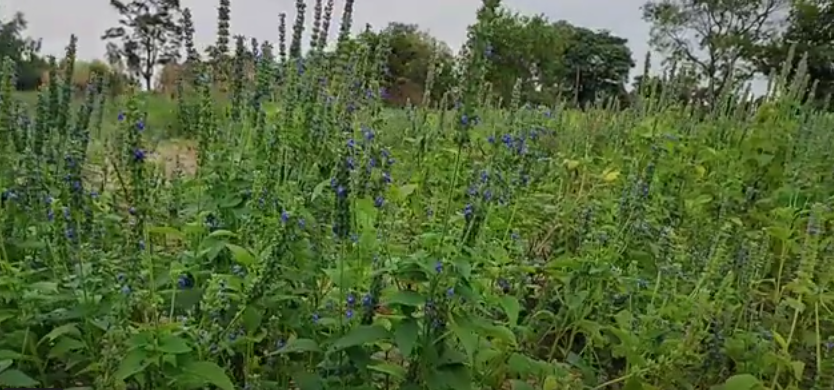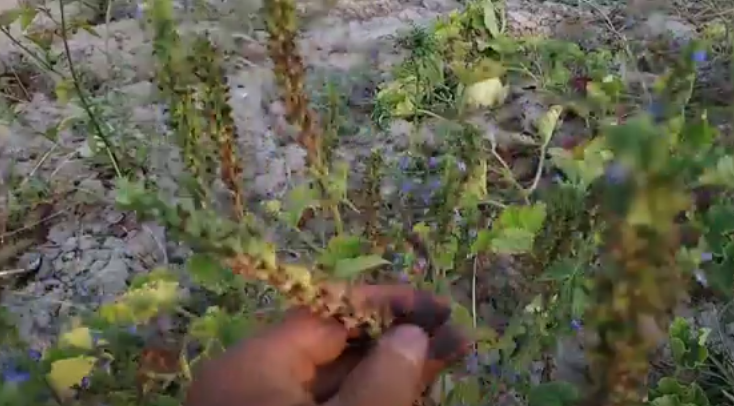Chia Seed Cultivation in India

Chia seeds (Salvia hispanica) called mealy cup sedge, are native to Texas and Mexico Chia was domesticated nearly 4,500 ago in Mesoamerica and was used as both food and medicine. It is a shrubby, clump-forming, tender perennial that grows 1.5-3′ tall on erect, branching, square stems.
They are edible seeds belonging to the mint family (Lamiaceae) Chia seeds are oval in shape and gray in color with black and white spots on them Chai seed have a diameter of approx. 2 millimeters (0.08 inches). The seeds are hygroscopic, absorbing up to approx. 12 times their weight in liquid when Chia seeds are soaked, they develop a mucilaginous coating that provides chia-based foods and beverages with a distinctive gel texture.
It rarely requires fewer inputs or fertilizer for cultivation. Chia seeds can be used as toppings for a variety of foods. The successful cultivation of the chia crop on farm fields will benefit the farm economy. Its cultivation will also improve living standards and health as a medicine for the people.
The major growing state of this crop are M.P., A.P. Gujrat, Karnataka, Rajasthan and Haryana
Health Benefits of Chia Seeds ;
With an increase in global health awareness, there is a greater demand for health-benefit foods because of the following reasons:
- Chia seeds are one of the richest source of Omega-3 Fatty Acids
- Chia seeds are abundant in dietary Fibre for digestive wellness.
- It Supports Weight Loss Efforts
- It helps Regulate Blood Sugar Levels
- Its intake promotes Heart Health
- Chia seeds are packed with Antioxidants
- It supports Bone Health
- It Boosts Energy and Metabolism
- Supports Skin Health
- Chia seeds are highly Versatile and Simple to add in to our Diet
Nutritive Value of Chia Seeds;
| Serving Size: 100 g | DV | |
| Calories | 490 kcal | 24% |
| Total Carbohydrate | 43.8 g | 15% |
| Dietary Fiber | 37.7 g | 15.10% |
| Total Fat | 30.8 g | 47% |
| Saturated Fat | 3.2 g | 16% |
| Monosaturated Fat | 2.1 g | |
| Poly saturated Fat | 23.3 g | |
| Protein | 15.6 g | 31% |
| Calcium | 631 mg | 63% |
| Phosphorus | 948 mg | 95% |
| Potassium | 160 mg | 5% |
| Zinc | 3.5 mg | 23% |
| Copper | 0,2 mg | 9% |
| Magnese | 2.2 mg | 108% |
| Cholesterol | 0 mg | 0% |
| % Daily Value (DV) is based on a 2000-calorie diet. | ||
| DV may be higher or lower depending on Calorie needs | ||
Required climatic conditions for Chia Seeds Cultivation;
Chia plants are sensitive to frost and cold temperatures They grow best in temperatures between 16 to 26 °C, with a minimum of 11 °C and a maximum of 36 °C. Chia plants are short-day plants, with a threshold of 12–13 hours. They require moist soil to germinate, but they can grow in dry and wet conditions with 300–1000 mm of rainfall per year. Chia plants grow best at elevations between 400–2500 m above sea level, and conditions below 200 m are inadequate.
Soil and Land preparation for Chia Seeds Cultivation;
Chia seed cultivation requires light to medium clay or sandy soils. Well-drained and moderately fertile soils are required for its cultivation. The chia crop can withstand mild drought and acidic soils. Chia crops require moisture for seedling germination, while the maturing chia plant does not tolerate wet soils during growth. Its cultivation needs soil preparation by disruption and loosening. Soil with good drainage is preferable, and the pH level should ideally be between 6 – 8.5 for optimal results.
Types of Chia Seeds:

Time of Sowing:
Since chia is a short-day plant and cannot grow in the long-day season, the best seasons to plant and grow chia seeds are winter (late August to October) and early spring (mid-February to April) with temperatures between 9°C and 25°C. It cannot, however, withstand snow or frost.
Seed Rate of Chia seeds ;
In contemporary commercial production, chia seeds are typically sown at a rate of 2.5–3 kg per acre.
Propagation of Chia Crop ;
-
From seedsIn the fall, soak chia seeds in water until they look like frog eggs, then scatter them on the soil and cover lightly. Water daily until they sprout, which should happen in 5–7 days.From stem cuttingsSelect a healthy stem from a mature plant and cut it just below a leaf node with clean, sharp scissors or pruning shears. To stop the cutting from rotting, remove the leaves from the lower portion.
Fertilizer Required for chia seed cultivation ;
Chia seeds can be grown with low or no fertilizer application. However, some fertilizers that can help with chia growth include: A 90:60:75 kg NPK/ha fertilizer level can result in a higher yield per plant. which can happen within 3–14 days, you can start feeding them with a ¼ strength dose of fertilizer.Irrigation Required for Chia Seed Cultivation ;For higher yields, the chia crop should be irrigated often; the plan may require one to five irrigations per growing season, contingent on rainfall and the current climate.
Harvesting of Chia Seed Crop ;

- The time from seed to harvest is roughly 120–140 days.
- Harvesting can be done when the flowers lose their petals and begin drying out.
- Avoid flowers entirely brown; otherwise, you risk losing all the seeds.
- Use sterilized pruning snips or scissors to cut off the flower below the spike.
- Place the flowers in a paper bag. Store the bag in a warm, dry place, giving the flowers time to dry out completely.
- Shake the bag to release the seeds after one to two weeks.
yield ;
The average yield per acre is 350–400 kg of chia seeds.
